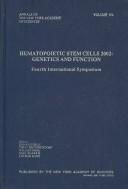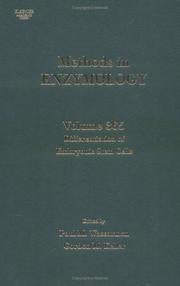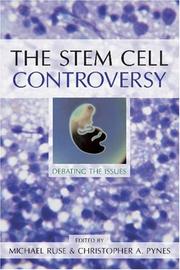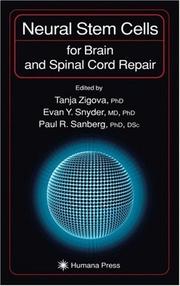| Listing 1 - 10 of 14 | << page >> |
Sort by
|
Dissertation
Abstract | Keywords | Export | Availability | Bookmark
 Loading...
Loading...Choose an application
- Reference Manager
- EndNote
- RefWorks (Direct export to RefWorks)

ISBN: 076372341X Year: 2003 Publisher: Sudbury (Mass.) : Jones and Barlett,
Abstract | Keywords | Export | Availability | Bookmark
 Loading...
Loading...Choose an application
- Reference Manager
- EndNote
- RefWorks (Direct export to RefWorks)
Embryo Research. --- Embryo --- Embryonic stem cells. --- Stem Cells. --- cytology.

ISBN: 1573314676 Year: 2003 Publisher: New York (N.Y.) : New York academy of sciences,
Abstract | Keywords | Export | Availability | Bookmark
 Loading...
Loading...Choose an application
- Reference Manager
- EndNote
- RefWorks (Direct export to RefWorks)
Genetic regulation --- Hematopoiesis --- Hematopoietic Stem Cells --- Hematopoietic Stem Cells --- Hematopoietic stem cell disorders --- Hematopoietic stem cells --- Hematopoietic stem cells --- physiology --- cytology --- physiology --- Growth
Book
Year: 2003 Publisher: [Washington, D.C.] : President's Council on Bioethics,
Abstract | Keywords | Export | Availability | Bookmark
 Loading...
Loading...Choose an application
- Reference Manager
- EndNote
- RefWorks (Direct export to RefWorks)
Embryo Research --- Bioethical Issues. --- Health Policy. --- Stem Cells. --- Stem cells --- Embryonic stem cells --- Bioethics. --- ethics. --- Research --- Moral and ethical aspects --- United States.
Book
Year: 2003 Publisher: Bruxelles: UCL,
Abstract | Keywords | Export | Availability | Bookmark
 Loading...
Loading...Choose an application
- Reference Manager
- EndNote
- RefWorks (Direct export to RefWorks)
The amino acid L-glutamate is the major excitatory neurotransmitter of the mammals central nervous system. Its role in several complex processes including memory, learning and neuronal plasticity is clearly established. After release in the synaptic cleft, glutamate must be imperatively eliminated to control the nervous transmission specificity and to avoid excitoxicity. By ensuring glutamate uptake through specific transporters, astroglial cells play a critical role in the maintenance of physiological extracellular concentrations of this amino acid. Considering the importance of glutamate in the development or in the progression of various neurodegenerative diseases, the control of the central glutamatergic activity, especially through pharmacological modulation of uptake systems, constitutes a promising therapeutic approach.
The discovery of undifferentiated cells present in the central nervous system of adult mammals has stimulated research concerning the nature and the functional significance of these fascinating stem cells. The possibility to induce the differentiation of these neural stem cells into astroglial cells in vitro has been already reported. However, these studies were frequently restricted to the description of typical astrocyte markers, mainly by immunocytochemistry. To our knowledge, this work constitutes the first specific research aimed at specifically study the expression and the functional properties of glutamate transporters in neural stem cells.
Immunological methods allowed us to reveal the early expression of the principal glutamate transporters (particularly GLAST and GLT1) in neural stem cells exposed to defined culture media that had been selected to favour differentiation into astrocytes ( detected by morphological examination and GFAP expression analysis). Moreover, we demonstrated specific glutamate uptake activity in these differentiated neural stem cells cultures. The following step of this research project should aim at understanding the role of the various chemical factors present in the culture supplements used in this work. Together, these studies should contribute to a better understanding of the mechanisms that control the expression of glutamate transporters during development and in the adult nervous tissue in vivo L’acide amine L-glutamate est le neurotransmetteur excitateur majeur du système nerveux central des mammifères. Son implication dans le développement de la mémoire, de l’apprentissage et de la plasticité neuronale est clairement établi. Une fois libéré dans l’espace synaptique, le glutamate doit impérativement être éliminé afin d’assurer la qualité de la transmission nerveuse et éviter le déclenchement de processus excitotoxiques. En assurant la capture de glutamate au travers de transporteurs spécifiques, les cellules gliales astrocytaires jouent à ce niveau un rôle capital. Etant donné l’importance du glutamate dans le développement ou la progression de diverses maladies neurodégénératives, le contrôle de l’activité glutamatergique centrale, entre autres par le biais de l’activation des systèmes de capture, apparait comme une approche de choix en thérapeutique.
La découverte de cellules indifférenciées résidant au sein du système nerveux central des mammifères adultes a stimulé la recherche concernant la nature et la signification fonctionnelle de ces cellules souches. La possibilité de différencier les cellules souches nerveuses en cellules gliales astrocytaires in vitro a déjà été rapportée dans la littérature. Cependant, ces travaux se sont souvent limités à la mise en évidence de marqueurs typiquement astrocytaires, essentiellement par immunocytochimie. A notre connaissance, ce travail constitue la première étude ayant pour but de spécifiquement étudier l’expression et la fonctionnalité des divers transporteurs du glutamate dans ces cellules.
En pratique, nous avons observé une expression précoce des principaux transporteurs du glutamate (en particulier GLAST et GLT1) dans des cellules souches nerveuses exposées à des milieux de culture favorables à la différenciation astrocytaire (détectée par examen morphologique et étude de l’expression de la GFAP). De plus, nous avons mesuré une activité de capture du glutamate spécifique au sein des cultures de ces cellules souches nerveuses différenciées. L’étape suivante de ce travail serait de mieux comprendre l(implication des différents facteurs chimiques présents dans les suppléments de culture utilisés. Ces travaux devraient ainsi contribuer à lieux comprendre les mécanismes qui contrôlent l’expression des transporteurs du glutamate au cours du développement et au sein des tissus nerveux dans l’organisme adulte
Excitatory Amino Acid Agents --- Stem Cells --- Cell Differentiation

ISSN: 00766879 ISBN: 0121822680 9786611037079 1281037079 0080546161 9780121822682 Year: 2003 Volume: 365 Publisher: Amsterdam ; Boston : Elsevier Academic Press,
Abstract | Keywords | Export | Availability | Bookmark
 Loading...
Loading...Choose an application
- Reference Manager
- EndNote
- RefWorks (Direct export to RefWorks)
This volume covers all aspects of embryonic stem cell differentiation, including mouse embryonic stem cells, mouse embryonic germ cells, monkey and human embryonic stem cells, and gene discovery.* Early commitment steps and generation of chimeric mice* Differentiation to mesoderm derivatives* Gene discovery by manipulation of mouse embryonic stem cells
Embryonic stem cells --- Stem cells. --- Cell Physiological Processes --- Embryonic Structures --- Cells --- Anatomy --- Cell Physiological Phenomena --- Phenomena and Processes --- Cell Differentiation --- Embryo, Mammalian --- Stem Cells --- Human Anatomy & Physiology --- Health & Biological Sciences --- Animal Biochemistry --- Embryonic Stem Cells. --- Embryonic stem cells. --- Cell differentiation. --- Cell fate specification --- Cell specification --- Differentiation of cells --- Fate specification of cells --- Specification of cells --- Embryonal stem cells --- Differentiation --- Fate specification --- Specification --- Morphogenesis --- Stem cells

ISBN: 1591020301 Year: 2003 Publisher: Amherst, N.Y. : Prometheus Books,
Abstract | Keywords | Export | Availability | Bookmark
 Loading...
Loading...Choose an application
- Reference Manager
- EndNote
- RefWorks (Direct export to RefWorks)
Stem cells --- Medical ethics --- Cellules souches --- Ethique médicale --- Moral and ethical aspects. --- Aspect moral --- Research

ISBN: 1588290034 Year: 2003 Publisher: Totowa Humana press
Abstract | Keywords | Export | Availability | Bookmark
 Loading...
Loading...Choose an application
- Reference Manager
- EndNote
- RefWorks (Direct export to RefWorks)
Cellular therapy --- Central nervous system --- Neural stem cells --- Diseases --- Treatment --- Transplantation
Book
Year: 2003 Publisher: Washington : U.S. Government Printing Office,
Abstract | Keywords | Export | Availability | Bookmark
 Loading...
Loading...Choose an application
- Reference Manager
- EndNote
- RefWorks (Direct export to RefWorks)
Stem cells --- Human embryo --- Federal aid to medical research --- Research --- Government policy

ISBN: 3540000259 Year: 2003 Publisher: Berlin Springer
Abstract | Keywords | Export | Availability | Bookmark
 Loading...
Loading...Choose an application
- Reference Manager
- EndNote
- RefWorks (Direct export to RefWorks)
Cell transplantation --- Cell transplantation --- Embryonic stem cells --- Embryonic stem cells --- Fetus --- Fetus --- Human rights --- Law and legislation --- Law and legislation --- Research --- Law and legislation --- Research --- Law and legislation --- Legal status, laws, etc --- Legal status, laws, etc
| Listing 1 - 10 of 14 | << page >> |
Sort by
|

 Search
Search Feedback
Feedback About UniCat
About UniCat  Help
Help News
News